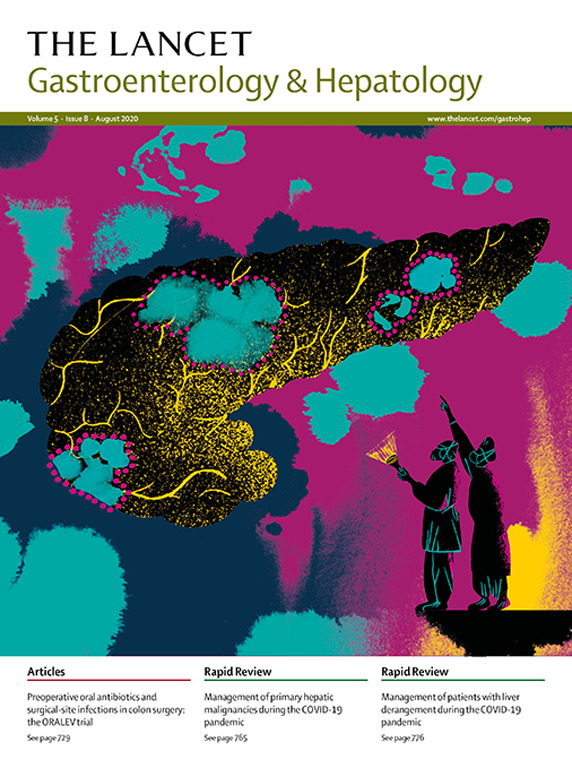估计每年在国家、区域和全球各级通过垂直传播感染丙型肝炎病毒的人数:一项数据综合研究
IF 38.6
1区 医学
Q1 GASTROENTEROLOGY & HEPATOLOGY
引用次数: 0
摘要
全球育龄妇女丙型肝炎病毒(HCV)负担仍然很高。研究估计,丙型肝炎病毒感染妇女所生的儿童中有7-12%将获得丙型肝炎病毒,尽管大约三分之二的儿童将在5岁时清除其丙型肝炎病毒感染。我们的目的是估计每年垂直传播HCV感染的数量,以及在国家或地区、区域和全球层面上仍有多少5岁以下病例。方法在这项数据综合研究中,我们通过结合来自几个来源的数据得出了HCV垂直传播的估计值:来自联合国的妇女人数、特定年龄生育率、0-5岁儿童死亡率和15-49岁妇女艾滋病毒流行率的数据;15-49岁妇女丙型肝炎病毒流行情况的模拟数据;HCV-HIV合并感染流行的meta分析数据;以及最近对丙型肝炎病毒垂直传播概率和随后按5岁清除概率的估计。每年携带HCV出生的人数是通过将5岁年龄组携带HCV的妇女人数乘以特定年龄组的出生率,分别乘以艾滋病毒状况,并乘以艾滋病毒状况特异性HCV垂直传播概率来估计的。出生时携带丙型肝炎病毒的人数乘以5岁时丙型肝炎病毒自然清除的概率,即死亡率。所有的估计都从它们的不确定性区间(ui)中采样1000次,以产生95%的ui。研究结果:据估计,全球每年通过垂直传播发生的HCV新感染人数为73 862例(95% UI 69 808-78 279)。南亚(21 245例[18 095 ~ 24 847])、西非(16 482例[14 873 ~ 18 283])和东非(8182例[7479 ~ 9085])是感染最多的地区。巴基斯坦(16 350例[13 325-19 844例])和尼日利亚(8483例[6944-10 184例])的负担最重,合计约占新感染病例的三分之一。我们估计这些儿童中有23120(20596 - 25813)人在5岁时仍然存活并携带HCV。有针对性的筛查政策检测和治疗HCV孕妇可以预防大量新的HCV感染;然而,需要关于孕妇丙型肝炎病毒治疗安全性的数据。本文章由计算机程序翻译,如有差异,请以英文原文为准。
Estimating the annual number of hepatitis C virus infections through vertical transmission at country, regional, and global levels: a data synthesis study
Background
The burden of hepatitis C virus (HCV) among women of childbearing age remains high globally. Studies have estimated that 7–12% of children born to women with HCV infection will acquire HCV, although around two-thirds of children will then clear their HCV infection by 5 years of age. We aimed to estimate the annual number of vertically transmitted HCV infections and how many cases remain at 5 years of age at the country or territory, regional, and global levels.Methods
In this data synthesis study, we produced estimates of vertical HCV transmission by combining data from several sources: data on the number of women, age-specific fertility rates, mortality rates among children aged 0–5 years, and HIV prevalence among women aged 15–49 years from the UN; modelled data on HCV prevalence among women aged 15–49 years; meta-analysis data on HCV–HIV co-infection prevalence; and recent estimates of the probabilities of vertical HCV transmission and subsequent clearance by age 5 years. The annual number of births with HCV was estimated by multiplying the number of women with HCV in 5-year age bands by age band-specific birth rates, separately by HIV status, and multiplying by HIV status-specific HCV vertical transmission probabilities. The number of births with HCV was multiplied by the probability of spontaneous clearance of HCV by 5 years of age, accounting for mortality. All estimates were sampled 1000 times from their uncertainty intervals (UIs) to produce 95% UIs.Findings
The estimated annual global number of new HCV infections occurring through vertical transmission was 73 862 (95% UI 69 808–78 279). Southern Asia (21 245 [18 095–24 847]), western Africa (16 482 [14 873–18 283]), and eastern Africa (8182 [7479–9085]) were the regions with the most infections. Pakistan (16 350 [13 325–19 844]) and Nigeria (8483 [6944–10 184]) had the largest burden and together accounted for around a third of new infections. We estimated that 23 120 (20 596–25 813) of these children would be alive and still have HCV when aged 5 years.Interpretation
Targeted screening policies that test and treat pregnant women with HCV could prevent substantial numbers of new HCV infections; however, data on the safety of HCV treatments in pregnant women are required.Funding
None.求助全文
通过发布文献求助,成功后即可免费获取论文全文。
去求助
来源期刊

Lancet Gastroenterology & Hepatology
Medicine-Hepatology
CiteScore
50.30
自引率
1.10%
发文量
0
期刊介绍:
The Lancet Gastroenterology & Hepatology is an authoritative forum for key opinion leaders across medicine, government, and health systems to influence clinical practice, explore global policy, and inform constructive, positive change worldwide.
The Lancet Gastroenterology & Hepatology publishes papers that reflect the rich variety of ongoing clinical research in these fields, especially in the areas of inflammatory bowel diseases, NAFLD and NASH, functional gastrointestinal disorders, digestive cancers, and viral hepatitis.
 求助内容:
求助内容: 应助结果提醒方式:
应助结果提醒方式:


